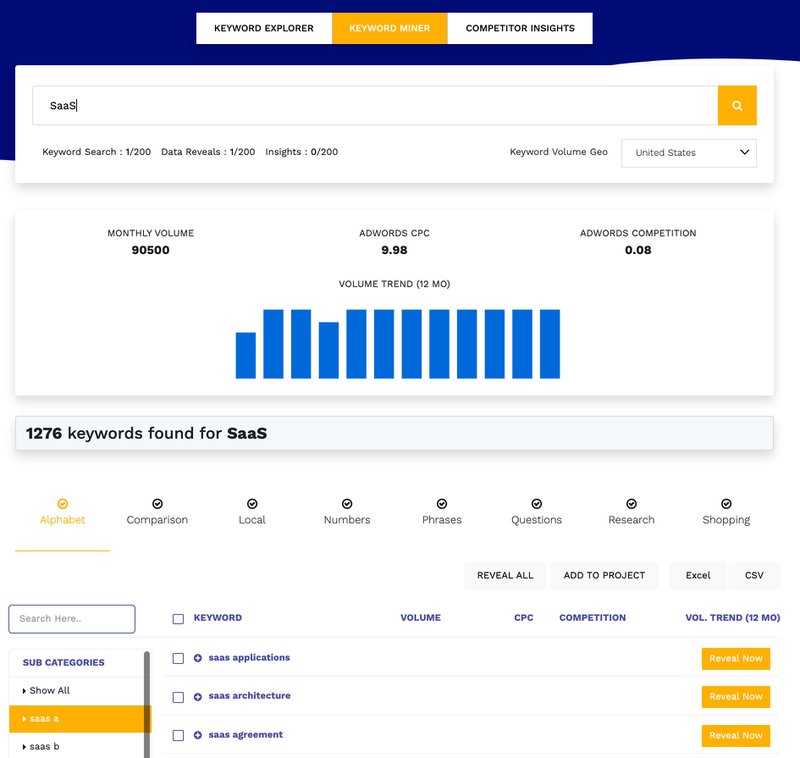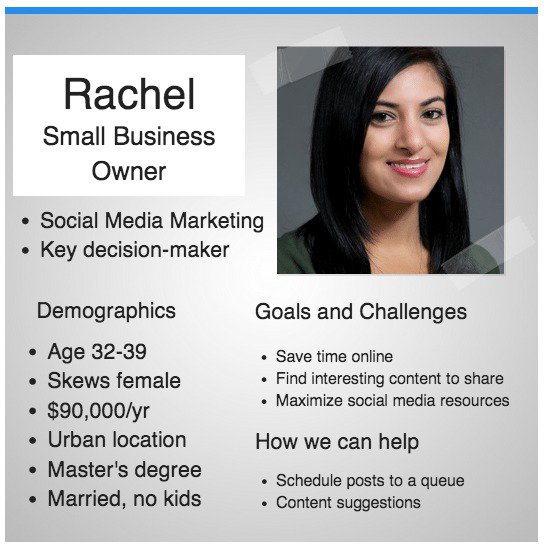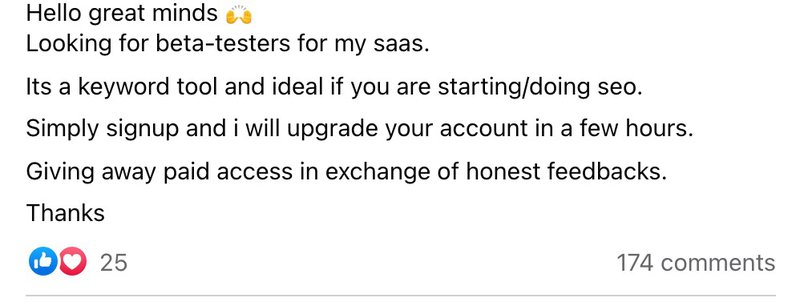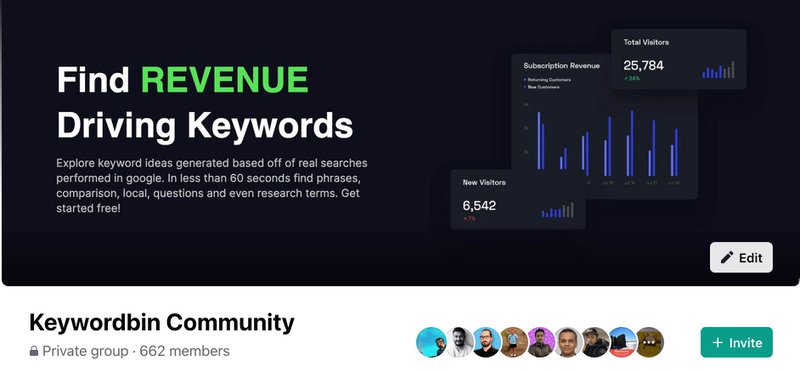When KeywordBin started, they looked for traction, early users willing to test out their platform, provide some feedback, and hopefully upgrade to paid plans. Now it's always easy to offer a free trial or 30-day access, but if no one cares or wants to use your product, then what's the use. So how do you fix this problem and get users into your app and make them loyal customers?
How to Get Your First 100 Users?
The process is thought to be complicated and difficult; however, it's fairly simple and can be broken down into these simple steps:
- Be sure your product solves a dire problem that users are looking for.
- Create a simple flow, core MVP, or product leading users to your solution.
- Find where your target audience hangs out online. This could be forums, Facebook groups, etc
- Create an irresistible offer, usually free access for 30 days in exchange for product feedback.
- Ask users who opt in to provide feedback in your private Facebook group.
- Offer those who participate in giving feedback an irresistible upgrade offer.
- Listen and implement feedback to retain and gain loyal brand ambassadors.
These steps can be used for ANY business, not just SaaS or online products. The process above is identical if you have a Shopify store, software, ebook, SaaS, or even a service. These simple steps allow you to find the right audience and gain beta testers, users, additional feedback, and even create your loyal private community! But as we laid this out, it might sound super simple and easy to do; however, you realize how this process is riddled with complexity when you get to do it. Let's break it down for you.
Does Your Product Solve a problem?
More times than not, people create elegant solutions to issues that don't exist or are not large enough to be applicable. Usually, this is because founders are thinking too narrow and isolated, with limited domain knowledge or experience.
Ask your self, does my solution:
- Save my customers time
- Save my customers cost
- Allow customers to solve their problem instantly
- Provide customers a way to jump the experience or domain knowledge gap they might have?
- Simplify operations, processes, or procedures.
- Apply to a large enough market that isn't too broad to target?
- Provide a solution to a problem critical enough that customers will pay to have it solved today.
If the answer is no to these, you might want to reevaluate the solution you are bringing to market. Not only will you have trouble finding traction and users, but you might also actually be wasting time, money, and resources. Want to learn more about how to do this the right way. We are sharing our framework that helps founders go from Idea to MVP. Sign up for the free email course to help you define your idea and get ready for onboarding users.
How to Launch in a Saturated Market
When KeywordBin was envisioned, many said that "it's just another keyword tool" or "The market is too saturated, and you won't get even 1o users". So how do you launch in a saturated market? Well, it again comes down to the problem you are solving. For KeywordBin, the founder wanted to create a simplified keyword research experience that used suggestions directly from google based on users' real live searches. While other tools were fixated on volume, KeywordBin would focus on search data suggestions provided by Google itself. What did this do differently? It gave users insights on what the next upcoming search term was as well as suggestions.
To take this even further, KeywordBin was simplified to provide a single input keyword and return hundreds and sometimes even thousands of variations based on Google's suggestions. Here is a small example below: Entering the keyword SaaS gives us 1276 suggestions generated by Google

Now, this is what we call a unique approach to a long-existing problem users face. This also overlaps with the idea that we need to provide users with a simple defined core user flow and solution as founders. In this case, the simplicity is evident; enter a keyword and get hundreds of suggestions, organized in categories from questions, numbers, research, shopping, etc.
In short, provide a unique approach to an existing solution and provide a simple UI/UX, in-fact so simple that maybe even a child could use it. Now, as your tool grows, you might feel the pains and KeywordBin has as well. As our products grow, we need to keep refining and providing better user experiences.
How to Find Your First 100 Users Online.
It's easy to find where your target audience hangs out online, but it's another thing to understand who your target audience is and where they are. Now data is key here, but what we are looking to do is create a filter, a means by which we will filter the data of millions of users to find our audience group.
How you create this filter depends a lot on your goals and who you think your business should be targeting. I will use a simplified approach here, so we don't go too deep into creating a customer persona. Here is a sample persona to give you an idea of how to think when creating these filters.

If you notice, this persona above highlights a few critical aspects.
- Job level
- Ability to make decisions
- Key demographic identifiers
- Challenges
- Solutions your product provides
Once you have your customer persona, seriously hit up Facebook!
Can I Find Beta Testers On Facebook?
Absolutely! And in my opinion, there is no better place to find users. Facebook is riddled with hundreds of thousands, if not millions of groups catering to every niche you can think of. I don’t mean to say that you join these groups and spam your product. But enter the groups that are catered to your customer persona challenges. You find users who are dealing with the issues you are looking to solve, so connect with these users, start discussions, understand their problems, and offer your solution as a way for them to see if it meets their needs.
Ideally, you would start this individually on a one-on-one basis, and going through 100-200 people does take time. Still, you make connections, build a customer network, and then ask the whole group to participate in your beta offer, you get tons of engagement. Here is an example below for KeywordBin where we had over 190 comments

Here is an example of another offer.

This one has over 174 comments! Now we kept repeating this formula, and we had over 1100 users in a few days! We then proceeded to invite these users into our group to gain valuable feedback. Users began using the software and posting their feedback. At the same time, our team worked on fixing critical issues and creating a roadmap focused around user challenges and pain points other tools could not or were not addressing.
The KeywordBin Community now has over 650+ members, and it's continually growing! You can do this too for your startups all within a week or two!

How Can I Convert Free Users to Paid Users?
Converting free users to paid users is probably one of the most highly asked questions that I encounter when having discussions with startup founders. Think of your brand as an ad. What is your irresistible offer? I notice that many times founders provide offers but are they genuinely irresistible?
1.Treat your early adopters very well.
These users are the ones that believed in you, your product and helped iron out the issues. You should add these users to an email list and tag them with VVIP, no, seriously. We ran an LTD for our product BacklinkSEO, and I wrote an excerpt which you can read on how to treat your customers.
2. Create trust by providing a solution
Often, products don’t solve the problems users are facing, and while that user is still figuring out how to make this solution work for them. They get a pesky email asking them to upgrade. Now, this is because we, as founders, are not understanding our customer journey well enough. We have an automation setup that doesn’t work when needed and is based on time, not actions. So be sure to reach out to customers and find out if your solution is solving their problems and once you know it is, then and only then do you offer them an irresistible offer.
3. Create an offer users can’t refuse
Creating an irresistible offer is probably easier said than done. But think about your costs, pricing, and what you can sustainably offer at a marginal profit. No, seriously, the goal here is to have these users become die-hard fans. Please give them a grandfathered price so low that it hurts them even to cancel. The offer should be so good they instead keep the plan than cancel it in fear of losing the fantastic deal they have. But do this strategically because once they are hooked, give them something more. Money!
4. Pay your users and pay them well!
Wait. What? Pay your users? That’s right, make them your brand ambassadors give them a grandfathered affiliate rate of 30-40%, the highest in your industry. Ask them to write a blog about your business, possibly as a review, make a video, share your product with their clients, get a review on capterra. If you solve a pain point for them, they will bend over backward for you to help you!
Where Are You In Your Journey?
Be sure to share where you are on your journey, and feel free to reach out. I love hearing about founders taking ideas to the next level. If you think I can help you with your startup journey, don’t hesitate to let me know how! I hope this helped steer you, gave you some ideas and insights, and I hope you can replicate this 10-20x with your business!

